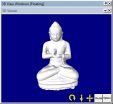VANCOUVER, BC, October 28, 2010 (Press-News.org) Eos Systems today announced the release of PhotoModeler 2010 and PhotoModeler Scanner 2010.
PhotoModeler, a Windows application, is used to create 3D models and measurements from photographs using ordinary digital cameras. PhotoModeler Scanner software adds the capability of creating dense point clouds like a laser or 3D scanner but eliminates the need for expensive and cumbersome equipment. The flexibility in using the ubiquitous digital camera offers sophisticated 3D capabilities for technical professionals and home users alike.
Both ends of this user spectrum have one thing in common: a seemingly insatiable appetite for 3D data, whether it is for creating industrial goods, performing scientific research, investigating crimes and accidents, developing video games and multimedia content, or just browsing through day-to-day information presented with the richness of 3D. The missing ingredient has always been a versatile, cost-effective and efficient method of generating 3D data for an infinite number of real world subjects of varying sizes and shapes. PhotoModeler is the missing ingredient.
With a new cornerstone feature in PhotoModeler Scanner 2010 called SmartMatch, the result can often be a stunning, photorealistic 3D model generated from photographs entirely automatically. SmartMatch detects and matches natural features in images - giving automated project setup and 3D data without the use of targets.
In addition, all of the software's core algorithms have been rewritten for higher performance, and many of the algorithms are now threaded to take advantage of modern multi-core CPUs. Comparing the previous version PhotoModeler 6 to the new PhotoModeler 2010 on a four core computer, a user may experience speed improvements of up to 4x in project processing, 16x with automatic target marking, and 32x during Dense Surface Model creation.
PhotoModeler 2010 is the culmination of two years of development, combining Eos' own research with feedback from our users, helping to push the new version onward to the key goals of more results, in less time, with less work.
In addition to the speed improvements and SmartMatch, other new features include support for geographic coordinates (geoids, map-systems, conversions); on-photo dimensions; an automated in-background project review; and a new External Geometry Explorer that consolidates control points, scale, rotation, external CAD file import and adds check distances, and multi-point affine. A complete list of new features can be found at: www.photomodeler.com/pm2010. A new set of tutorial videos describe many of the new capabilities in detail at www.photomodeler.com/tutorial-vids/online-tutorials.htm.
PhotoModeler 2010 has been in public beta testing since July and has garnered tremendous support. Bill Isenberger, Archaeologist/Cartographer and PhotoModeler 2010 beta tester sums it up well, "This is going to be another great upgrade!"
Pricing and Upgrades
PhotoModeler 2010 includes the Coded Target module, which was an extra-cost option previously. PhotoModeler 2010 is priced at $1,145USD. To upgrade from any previous PhotoModeler version is $445USD.
PhotoModeler Scanner 2010 is price reduced to $2,595USD, and the cost to upgrade from the previous version is $795USD. PhotoModeler customers can also trade up to PhotoModeler Scanner 2010 for $1,595USD.
All customers that purchased PhotoModeler 6 or PhotoModeler Scanner 6 on or after July 28th, 2010 are eligible for a free upgrade to the 2010 versions.
About Eos Systems.
Eos Systems, a privately held company based in Vancouver, Canada, is a world leader in the development of photogrammetry and 3D modeling technology. Eos has developed close-range photogrammetry software since 1990. Their award-winning PhotoModeler software and the PhotoModeler Scanner software are used worldwide by professionals in the fields of architecture, accident reconstruction, forensics, archaeology, engineering, surveying, film, and 3D animation.
www.photomodeler.com
3D From Your Camera: Eos Systems Announces PhotoModeler 2010
PhotoModeler feeds the insatiable appetite of professional and home users for 3D data and visualization, with 3D capture using your own camera.
2010-10-28
ELSE PRESS RELEASES FROM THIS DATE:
New guideline from ASH and ASCO recommends caution regarding ESA use in cancer patients
2010-10-27
(WASHINGTON, October 25, 2010) – An updated joint guideline by the American Society of Hematology (ASH) and the American Society of Clinical Oncology (ASCO) advises physicians about the appropriate use of erythropoiesis-stimulating agents (ESAs), a class of drugs that stimulate the bone marrow to produce more red blood cells, to treat cancer patients with chemotherapy-induced anemia. While the guideline cautions that ESAs are associated with shorter survival and increased risk of thromboembolism — blood clots — and tumor progression, it also recognizes their major benefit ...
New class of biomolecules triggered in response to respiratory virus infection
2010-10-27
For the first time, scientists have discovered that a poorly understood class of RNA produced in a mammal's cells during a respiratory virus attack may affect the outcome of the infection. Their findings are reported today in mBio, a journal of the American Society for Microbiology.
RNA (ribonucleic acid) contains information transcribed from the cell's instruction manual, its DNA. The best known of these RNAs translate sections of DNA code into building blocks for proteins.
Most studies of how animals' cells respond to virus infection typically look at protein-coding ...
Landmark study finds high resting heart associated with shorter life expectancy
2010-10-27
Montreal −If you are a person who already has stable heart disease, how fast your heart beats at rest can predict your risk of dying, not only from heart disease but all other causes, Dr. Eva Lonn told the Canadian Cardiovascular Congress 2010, co-hosted by the Heart and Stroke Foundation and the Canadian Cardiovascular Society.
"The higher the heart rate, the higher the risk of death from cardiovascular and all causes, even after adjusting for all risk factors that could confound our results," says Dr. Lonn, a cardiologist and professor at McMaster University. ...
Severe sepsis associated with development of cognitive and functional disability in older patients
2010-10-27
Older adults who survived severe sepsis were more likely to develop substantial cognitive impairment and functional disability, according to a study in the October 27 issue of JAMA.
Hundreds of thousands of patients endure severe sepsis each year in the United States, according to background information in the article. "Although severe sepsis is the most common non-cardiac cause of critical illness, the long-term impact of severe sepsis on cognitive and physical functioning is unknown," the authors write.
Theodore J. Iwashyna, M.D., Ph.D., of the University of Michigan ...
Patients who survive sepsis are more than 3 times as likely to have cognitive problems
2010-10-27
Ann Arbor, Mich. — Older adults who survive severe sepsis are at higher risk for long-term cognitive impairment and physical limitations than those hospitalized for other reasons, according to researchers from the University of Michigan Health System.
Research to be published Oct. 27 in the Journal of the American Medical Association showed that 60 percent of hospitalizations for severe sepsis were associated with worsened cognitive and physical function among surviving older adults. The odds of acquiring moderate to severe cognitive impairment were 3.3 times higher ...
Colorectal cancer patients with gene mutation show better response to cancer agent
2010-10-27
Even though the cancer-treatment agent cetuximab is not considered effective treatment for KRAS (a gene)-mutated metastatic colorectal tumors, new research indicates that patients with colorectal cancer not responding to chemotherapy and a certain variation of this gene who were treated with cetuximab had longer overall and progression-free survival than patients with other KRAS-mutations, according to a study in the October 27 issue of JAMA.
"Recent retrospective correlative analyses of metastatic colorectal cancer trials indicate that patients with KRAS-mutated tumors ...
2 clinical trials demonstrate effective weight loss strategies for obese and overweight adults
2010-10-27
Lifestyle interventions, including physical activity and structured weight loss programs, can result in significant weight loss for overweight, obese and severely obese adults, according to two reports that were posted online October 9 by JAMA. The studies and accompanying editorials were made available early online to coincide with the presentation of these papers at the 28th Annual Scientific Meeting of the Obesity Society. The articles appear in the October 27 print issue of JAMA.
According to background information in the papers, obesity is among the most significant ...
Genetic variations linked with worse outcomes with use of antiplatelet drug for cardiac procedures
2010-10-27
An analysis of data from previously published studies indicates that use of the antiplatelet drug clopidogrel for patients who have common genetic variants of a certain gene and are undergoing a procedure such as coronary stent placement have an associated increased risk for major adverse cardiovascular events, particularly development of blood clots in stents, according to a study in the October 27 issue of JAMA.
Clopidogrel, one of the most commonly prescribed medications, has been shown to reduce cardiovascular events in patients undergoing percutaneous coronary intervention ...
Better transparency needed on medical journals' competing interests
2010-10-27
Journals need to develop policies to handle the inevitable competing interests that arise when they publish papers that may bring them reprint revenue or increase their impact factors. This is the conclusion of a research article by Andreas Lundh and colleagues from the Nordic Cochrane Centre published in this weeks PLoS Medicine. An accompanying perspective by Harvey Marcovitch, ex-chair of the Committee on Publication Ethics (COPE), and an editorial from the PLoS Medicine Editors discusses this issue further, concluding that journals should apply the same degree of transparency ...
WHO pesticide regulations should be based on toxicity in humans, not rats
2010-10-27
Current WHO pesticide classifications are based on toxicity in rats but basing regulation on human toxicity will make pesticide poisoning less hazardous and prevent hundreds of thousands of deaths globally without compromising agricultural needs. These are the key findings from a study by Andrew Dawson (South Asian Clinical Toxicology Research Collaboration, University of Peradeniya, Sri Lanka) and colleagues published in this week's PLoS Medicine.
The single most common means of suicide worldwide is agricultural pesticide poisoning. The authors examined the proportion ...
LAST 30 PRESS RELEASES:
Manta rays create mobile ecosystems, study finds
Study: Mixed results in using lipoic acid to treat progressive multiple sclerosis
Norbert Holtkamp appointed director of Fermi National Accelerator Laboratory
New agentic AI platform accelerates advanced optics design
Biologists discover neurons use physical signals — not electricity — to stabilize communication
Researchers discover that a hormone can access the brain by hitchhiking
University of Oklahoma researcher awarded funding to pursue AI-powered material design
Exploring how the visual system recovers following injury
Support for parents with infants at pediatric check-ups leads to better reading and math skills in elementary school
Kids’ behavioral health is a growing share of family health costs
Day & night: Cancer disrupts the brain’s natural rhythm
COVID-19 vaccination significantly reduces risk to pregnant women and baby
The role of vaccination in maternal and perinatal outcomes associated with COVID-19 in pregnancy
Mayo Clinic smartwatch system helps parents shorten and defuse children's severe tantrums early
Behavioral health spending spikes to 40% of all children’s health expenditures, nearly doubling in a decade
Digital cognitive behavioral treatment for generalized anxiety disorder
Expenditures for pediatric behavioral health care over time and estimated family financial burden
Air conditioning in nursing homes and mortality during extreme heat
The Alps to lose a record number of glaciers in the next decade
What makes a good proton conductor?
New science reporting guide published for journalists in Bulgaria
New international study reveals major survival gaps among children with cancer
New science reporting guide published for journalists in Turkey
Scientists develop a smarter mRNA therapy that knows which cells to target
Neuroanatomy-informed brain–machine hybrid intelligence for robust acoustic target detection
Eight SwRI hydrogen projects funded by ENERGYWERX
The Lundquist Institute and its start-up company Vitalex Biosciences Announces Strategic Advancement of Second-Generation fungal Vaccine VXV-01 through Phase 1 Trials under $40 Million Competitive Con
Fine particles in pollution are associated with early signs of autoimmune disease
Review article | Towards a Global Ground-Based Earth Observatory (GGBEO): Leveraging existing systems and networks
Penn and UMich create world’s smallest programmable, autonomous robots
[Press-News.org] 3D From Your Camera: Eos Systems Announces PhotoModeler 2010PhotoModeler feeds the insatiable appetite of professional and home users for 3D data and visualization, with 3D capture using your own camera.



